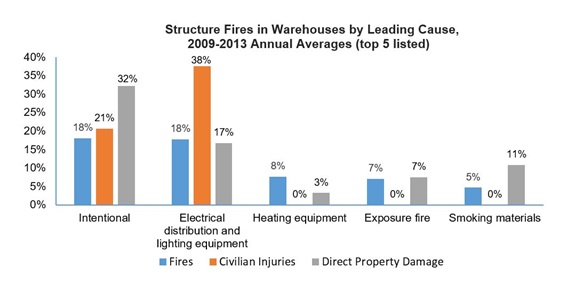LAFD and NFPA: Nightclub Fires, Warehouse Fires, and What You Can Do
In the wake of the recent tragic Oakland warehouse fire on Friday, December 2, 2016, your Los Angeles Fire Department (LAFD) along with our friends at National Fire Protection Association (NFPA) wish to provide timely information on three topics:
- Nightclub Fires
- Warehouse Fires
- What you can do to ensure safety.
As the search continues for deceased victims of a Friday night fire during a party at a converted two-story warehouse in Oakland, CA, we would like to provide you the following timely information.
1. Information about nightclub fires...
Fires in assembly occupancies have shown to be some of the most deadly when the proper features, systems and construction materials were not present. Nightclubs, theaters and auditoriums differ from office buildings because they contain a large number of people in one main space. NFPA code provisions mandate that a considerable number of safety systems and features be present in order to keep everyone safe should an unwanted fire occur. The level of safety provided is not the result of any single safety system or feature, but rather is achieved through the combination of multiple safeguards that are provided.
2. Information about warehouse fires...
Warehouses present special challenges for fire protection because their contents and layouts are conducive to fire spread and present obstacles to manual fire suppression efforts. Using data from the National Fire Incident Reporting System and the NFPA Fire Experience Survey, we estimated annual fires and losses during 2009-2013.
Report highlights
- U.S. fire departments responded to an estimated average of 1,210 fires in warehouse properties per year (excluding refrigerated or cold storage), which represents less than 1% of all structure fires.

- These fires caused an annual average of $155 million in direct property damage, three civilian deaths, and 19 civilian injuries.
- Fires that were intentionally set and fires caused by electrical distribution and lighting equipment were the leading causes of warehouse fires, each with 18% of the total.
- Flammable and combustible liquids and gases, piping and filter were the item first ignited in 6% of fires, but these fires caused 31% of civilian injuries and 12% of direct property damage.
3. Here's what you can do to ensure you are safe when entering a Assemblage Building...
Every day, millions of people wake up, go to work or school, and take part in social events. But every so often the unexpected happens: an earthquake, a fire, a chemical spill, an act of terrorism or some other disaster. Routines change drastically, and people are suddenly aware of how fragile their lives and routines can be. Each disaster can have lasting effects - people may be seriously injured or killed, and devastating and costly property damage can occur. People entering any public assembly building need to be prepared in case of an emergency.
Before you enter
- Take a good look. Does the building appear to be in a condition that makes you feel comfortable? Is the main entrance wide and does it open outward to allow easy exit? Is the outside area clear of materials stored against the building or blocking exits?
- Have a communication plan
Identify a relative or friend to contact in case of emergency and you are separated from family or friends. - Plan a meeting place
Pick a meeting place outside to meet family or friends with whom you are attending the function. If there is an emergency, be sure to meet them there.
When you enter
- Locate exits immediately
When you enter a building you should look for all available exits. Some exits may be in front and some in back of you. Be prepared to use your closest exit. You may not be able to use the main exit. - Check for clear exit paths
Make sure aisles are wide enough and not obstructed by chairs or furniture. Check to make sure your exit door is not blocked or chained. If there are not at least two exits or exit paths are blocked, report the violation to management and leave the building if it is not immediately addressed. Call the local fire marshal to register a complaint. - Do you feel safe?
Does the building appear to be overcrowded? Are there fire sources such as candles burning, cigarettes or cigars burning, pyrotechnics, or other heat sources that may make you feel unsafe? Are there safety systems in place such as alternative exits, sprinklers, and smoke alarms? Ask the management for clarification on your concerns. If you do not feel safe in the building, leave immediately.
During an emergency
- React immediately
If an alarm sounds, you see smoke or fire, or other unusual disturbance immediately exit the building in an orderly fashion. - Get out, stay out!
Once you have escaped, stay out. Under no circumstances should you ever go back into a burning building. Let trained firefighters conduct rescue operations.









